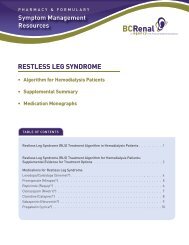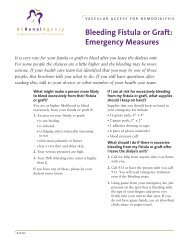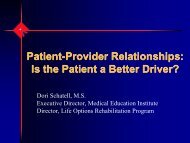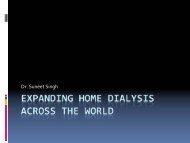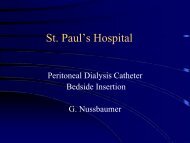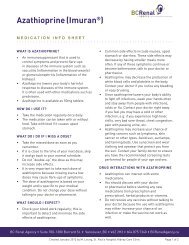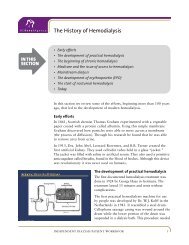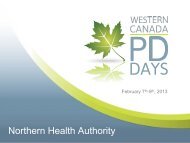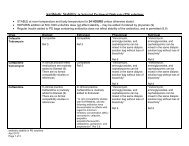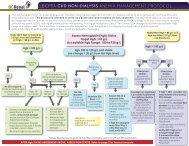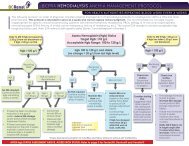Palliative Care Education and Practice - BC Renal Agency
Palliative Care Education and Practice - BC Renal Agency
Palliative Care Education and Practice - BC Renal Agency
You also want an ePaper? Increase the reach of your titles
YUMPU automatically turns print PDFs into web optimized ePapers that Google loves.
Symptoms during Last 24 HoursN=79SymptomPainAgitationMyoclonus/twitchingDyspnea/agonal breathingFeverDiarrheaDysphagiaNausea% present4230282520141413Cohen et al. AJKD, 2000;36:140-1444
Exposure to <strong>Palliative</strong> <strong>Care</strong>GeriatricsCritical<strong>Care</strong>NephrologyCompleted a Rotation Focusedon <strong>Palliative</strong> <strong>Care</strong>71%2%1%Had Contact with <strong>Palliative</strong><strong>Care</strong> Specialist80%46%45%Quality of teaching withrespect to end-of-life carerated ‘very good’ or‘excellent’53%34%15%Why the Nephrology Community should care about EOL care.Alvin Moss MD. Center for ethics <strong>and</strong> Law. Section of Nephrology. West Virginia University.5
Objectives• <strong>Palliative</strong> care: a definition.• A good death <strong>and</strong> a way to evaluate.• How to share bad news.• What is suffering?• Hope.• The “DNR”• Cachexia, delirium, etc. <strong>and</strong> the ESAS.• Pain <strong>and</strong> analgesics.• Psychiatric consequences of terminal illness.• Bereavement.
<strong>Palliative</strong> <strong>Care</strong>A definition• A comprehensive, interdisciplinaryservice, focusing on providing quality oflife for patients living with a terminalillness <strong>and</strong> for their families.
PCEPEnd of Life <strong>Care</strong> is just one aspect of<strong>Palliative</strong> <strong>Care</strong>
What is a good death?<strong>Palliative</strong> <strong>Care</strong>(Steinhauser et al. JAMA Nov 15, 2000. 284(19), p2476-2482)• Free of pain• Be mentally aware• At peace with God• In the presence of family• Not a burden to family• Treatment choices followed• Finances in order• Have funeral arrangements planned• Not be a burden to society• Resolve conflicts• Feel one’s life is complete/legacy• Die at home.
PCEP• How to give bad news• How to listen• How to use silence effectively during a patient encounter• How to reframe goals to focus on the achievable• Small things/words make a huge difference• Know the patient as a WHOLE person…spiritual/religion• “Culture” may be macro or micro
Talking with patients about a life-threatening illness.• Hearing bad news: “How did you find out?”• Information sharing <strong>and</strong> prognosis.• Effects of the illness on the person.The experience, physical, emotional, concerns, surprises.• Past, present <strong>and</strong> future.• Supports: Informal <strong>and</strong> formal.• Spirituality.• Facing the reality: thoughts about death <strong>and</strong> dyingPlans: practical: will, affairs, burial, SDM, AD.
Talking with patients about a life-threatening illness.• Personhood <strong>and</strong> how has this been affected.• Reconciliation <strong>and</strong> closure:how to make the events meaningful,saying the previously unsaid,saying goodbye.• Legacy
Sharing bad news• Appropriate setting• Prepare yourself (rehearse key points)• Consider involving family/SDM (ask the patient)• Begin by aligning knowledge• “Warning shot”• Be brief <strong>and</strong> simple (key message)• Be honest- avoid false reassurances• Listen- allow time for patient to respond (tolerate silence)• Listen…affirm…pause…listen• Convey support/caring (touching is OK)• Offer next steps• Communicate with team/document the discussion.
PERSPECTIVES ON CARE AT THE CLOSE OF LIFEEstablishing Trust With Hospitalized Patients• Encourage Patients <strong>and</strong> Families to Talk• Do Not Contradict or Put Down Other Health<strong>Care</strong> Providers, Yet Recognize Patient Concerns• Acknowledge Errors• Be Humble• Demonstrate Respect
PERSPECTIVES ON CARE AT THE CLOSE OF LIFEEstablishing Trust With Hospitalized PatientsTaking care of patients in the hospital often requires physicians to developrelationships quickly <strong>and</strong> does not allow much time to engender trust throughexperience. The following may help:• Encourage Patients <strong>and</strong> Families to Talk• "Tell me what you underst<strong>and</strong> about your illness."• "We've just met <strong>and</strong> there is so much going on with you right now. To help me getto know you better, can you tell me about your life outside of the hospital?"• "I'm sure that this illness has been a lot to absorb quickly. How are you coping withthis?"
PERSPECTIVES ON CARE AT THE CLOSE OF LIFE• Do Not Contradict or Put Down Other Health <strong>Care</strong>Providers, Yet Recognize Patient Concerns• "I hear you saying that you didn't feel heard by the otherdoctors. I'd like to make sure that you have a chance tovoice all of your concerns."• "It sounds like Dr Jones left you feeling very hopeful for acure. I'm sure he really cares about you, <strong>and</strong> it would havebeen wonderful if things would have gone as well as hewished. "
PERSPECTIVES ON CARE AT THE CLOSE OF LIFE• Acknowledge Errors• "You're absolutely right. Four days was too long tohave to wait for the CT scan. Any excuses we havewon't make you feel better.“
PERSPECTIVES ON CARE AT THE CLOSE OF LIFE• Be Humble• "I really appreciate what you've shared with meabout the side effects of the medication. It's clearthat the approach I had suggested is not going towork for you."
PERSPECTIVES ON CARE AT THE CLOSE OF LIFE• Demonstrate Respect• "I am so impressed by how involved you've beenwith your father throughout this illness. I can tellhow much you love him."
SufferingSuffering• A symptom is not suffering• Loss of personal integrity is suffering
SufferingLoss of integrity as a person.• Loss of self-esteem• Loss of privacy• Loss of control/change of bodily functions• Loss of intellect• Ab<strong>and</strong>onment• Loss of physical capabilities• Uncontrolled pain• Uncontrolled nausea
Hope <strong>and</strong> the prospect of healing atthe end of life.C. Feudtner JACM Vol 2, Suppl 1, 2005, S23-S30• Human healing represents the attainment of anholistically conceived health-related goal.• Individuals experience hope when they have anexpectation that a desired goal can be achieved.
Addressing Hope Explicitly• “What are you hoping for?”• “How are these hopes faring?”• = the point of empathic entry.
Hope• Framing• Anchoring• Revising the frame, resetting the anchor:i.e. “re-goaling”• “Is it time to emphasize different goals?”
Aspects of hope/fear• Identity, meaning <strong>and</strong> life story narratives.• Self-efficacy <strong>and</strong> loss of control.• The threat of senselessness.
Hope• Hope is a powerful influence in our lives.• Hope is potentially everywhere, including at thebedside of someone dying.• When mobilized effectively, hope is precious.• Patients <strong>and</strong> families care intensely about hope.
PCEP• DNR / DNAR / DNI / AND• AND….allow natural death
DNR: discussion <strong>and</strong> resolution• Answer “miracle” wish with “I wish that werepossible”• What is the best way to love your…….?• Redirect energy for cure to energy to fight for thecomfort of the patient• NB when talking to family, DO NOT say: “Whatkind of person WAS your husb<strong>and</strong>.”
DNR: discussion <strong>and</strong> resolution• Strive for mutual underst<strong>and</strong>ing• Clarify goals• Build an alliance with patient <strong>and</strong> family• Make a recommendation:informs family that such an option is legal, moral, compassionate• Avoid “do you want everything done”• Emphasize on-going care, no ab<strong>and</strong>onment• Shift in goals of care• When conflict, discover the REAL issue
DNR discussionMrs A.We haven’t approached the way he died. It wasabsolutely disgusting…that pushing himconstantly as to whether he wanted heroicmeasures of care. We had a lot of irritation. Itwas insensitive. He had made his wishes clear –he did not want valiant measures.
Recognizing <strong>and</strong> managing affect inan emotionally chargedenvironment.
Managing Affect• Declare the obvious re the present(sadness, frustration, anger)• Explore the future & its emotions• Empathetic agreement(expression of wishes)
Psychiatric consequences of aTerminal Illness50-65% patients with advanced disease have apsychiatric disorder, most commonly:• Adjustment disorder 11-35%• Major depression 5-26%• Anxiety disorder 6-14%• High comorbidity 7.5-35%Miovic M, Block S. Cancer 2007: 110(8)
Adjustment disorder• May include anticipatory grieving• Emotional/behavioral sx’s in excess of normal for a givenstressor.• Demoralization.• Situational anxiety/depressive sx’s below syndromalthreshold.• SSRIs ineffective• Control symptoms, search for meaning, dignity
Grief vs DepressionGrief• Normal response to loss• Mild neuro-veg symptoms• Comes in waves• Fleeting or passive SI• Ability to enjoy life <strong>and</strong> plan• Can still find meaning• Crying is an emotional releaseDepression• Abnormal response• Prominent neuro-veg symptoms• Constant hopelessness• Frequent or active SI• Anhedonia, guilt++, future bleak• Hard to find meaning• Crying is draining• Sustained irritability <strong>and</strong>/or anger
Supporting the survivors.• Reassure family members that their response to the patient's death isnormal.• Listen sympathetically if they wish to review the circumstances of thepatient's death.• Reassure the family that you will remain available to them to helpthem with their grieving.• During the first year call or write to the family at regular intervals,don't wait for them to make contact.• Offer to send educational materials on manifestations of grief, copingtechniques <strong>and</strong> professional resources, if the family wish.• Invite the family to participate in a memorial service.• Identify family members at high risk for prolonged, intense grief<strong>and</strong> arrange a referral for professional support even before that patientdies.
PatientMr A.78 years old.Long H/O Diabetes, hypertension, CAD,CHF, ESRD, dies in renal failure after a 10week hospitalization.
AngerMrs A.We haven’t approached the way he died. It wasabsolutely disgusting…that pushing himconstantly as to whether he wanted heroicmeasures of care. We had a lot of irritation. Itwas insensitive. He had made his wishes clear –he did not want valiant measures.
BereavementMrs A.My husb<strong>and</strong>’s doctor….as soon as myhusb<strong>and</strong> died, that was the end of him.That’s one of the things that I object to: allthe doctors suddenly go…there’s nosupport.
Bereavement Call• Suggested texts when telephoning bereaved relatives after a death.• Hello Mrs/Mr/.......• This is Dr.......calling. The purpose of my call is to offer my condolences to you <strong>and</strong>your family after the death/passing of ........• It has been/was a privilage to have been associated with the medical care of ........ forthe last......months/years. I have been impressed by his/her strength in the face ofhis/her illness <strong>and</strong> the dignified way in which he/she faced the final stages of his/herlife. This has been an inspiration to me, my medical <strong>and</strong> nursing colleagues, <strong>and</strong> theother patients who so valued their association with him/her. .........will be missedby his/her renal/dialysis “family”.• This must be a very busy <strong>and</strong> difficult time for you, so I do not want to take up toomuch of your time, but please don't hesitate to contact me, or one of the othermembers of the renal team if there is anything we can help you with.
Writing a condolence letter.• Acknowledge the loss <strong>and</strong> name the deceased.• Express your sympathy...remind the bereaved thatthey are not alone in their grief.• Note special qualities of the deceased.• Recall a memory of the deceased.• Remind the bereaved of their personal strengths.• Offer help, but be specific <strong>and</strong> be prepared to followthrough.• End with a word or phrase of sympathy.
Writing a condolence letter.DearI felt that I wanted to write to you because I have been thinking increasingly about your latehusb<strong>and</strong>/father/brother/sister/mother _________ as I walk through the wards of St.Paul’s/VGH/other hospital.I fondly remember _______ courage <strong>and</strong> humour despite the seriousness of his/her illness. Iremember too his/her unfailing love of the work he/she did <strong>and</strong> how he/she placed aphotograph of________________near his/her bed in the ward at __ Hospital.His/her strength has left an indelible memory <strong>and</strong> has once again taught me how the humanspirit can overcome almost all adversity.I hope that you <strong>and</strong> your remarkable children are finding your own strength to overcomeyour loss.With fondest regards.Yours sincerely,
Cachexia, delirium, etc. <strong>and</strong> theESAS
Let’s Interpret This PictureAssumption‣TPN for malnutritionIn Actuality‣Malnutrition is NOT the problem,catabolism <strong>and</strong> protein breakdowndue to tumour cytokines,inflammation, etc… is the issue.
• Anorexia• Nausea• CachexiaSymptom <strong>and</strong> Signs• Asthenia, depression, delerium.Common to most terminal illnesses, neoplastic,heart failure, renal failure, TB• Leptin, Ghrelin, CCK.Tumour byproducts, metabolites, electrolytes,inflammatory cytokines <strong>and</strong> brain function!
Symptoms during Last 24 HoursN=79SymptomPainAgitationMyoclonus/twitchingDyspnea/agonal breathingFeverDiarrheaDysphagiaNausea% present4230282520141413Cohen et al. AJKD, 2000;36:140-14450
ESAS
Associations Between End-of-Life Discussions,Patient Mental Health, Medical <strong>Care</strong> Near Death,<strong>and</strong> <strong>Care</strong>giver Bereavement Adjustment.A.A. Wright et al JAMA. 2008;300(14):1665-1673Advanced Cancer Patients. 123/332 (37%) had EOL discussions.• NO increased rate of depression 5.8% vs 8.3% OR 1.33• NO increased rate of worry 6.5% vs 7.0% p = 0.19• Decreased rates ofVentilation 1.6% vs 11.0% (p = 0.02)Resuscitation 0.8% vs 6.7% (p = 0.02)ICU admission 4.1% vs 12.4% (p = 0.02)Hospice care 5.6% vs 44.5% (p = 0.03)
EOL DiscussionsMore aggressive medical care led to:• Worse patient QOL (K score) 6.4 vs 4.6 (p= 0.01)• More depression in the bereaved O.R. 3.37 (CI 95%)• Hospice QOL 6.9 vs 5.6
Associations Between End-of-Life Discussions,Patient Mental Health, Medical <strong>Care</strong> Near Death, <strong>and</strong><strong>Care</strong>giver Bereavement Adjustment.A.A. Wright et al JAMA. 2008;300(14):1665-1673




